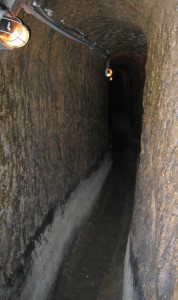 For some time, “Naples Sotteranea,” or “Underground Naples,” has been a draw for travelers from around the world. The tunnels and caverns beneath the historic Italian city are built on a porous type of rock called “tufo,” the result of centuries of hardening of volcanic ash. (The photo to the right is of an old water tunnel underneath Naples.)
For some time, “Naples Sotteranea,” or “Underground Naples,” has been a draw for travelers from around the world. The tunnels and caverns beneath the historic Italian city are built on a porous type of rock called “tufo,” the result of centuries of hardening of volcanic ash. (The photo to the right is of an old water tunnel underneath Naples.)
While much of the space underneath Naples has been well explored, recently local geologist Gianluca Minin told The Times of London that “An elderly Neapolitan wrote us describing incredible stairways and huge chambers that no-one remembered.” Minin and a colleague dug out “tons of rubble” and found 1000 square meters of passageways, a 17th-century cistern, and other chambers, some used as lavatories during World War II when fascist authorities ordered construction of bomb shelters.
The 90-year-old man, a war veteran who is not identified in the article, remembered sheltering from air raids in the newly discovered spaces. Minin said that some local people who survived the war “knew their way around blindfold [sic]” when they returned. “One went into a kind of trauma, knelt down on the ground, and said ‘Has the bombing stopped?’”
Minin and his colleague Enzo De Luzio found things just as their source described: An area about the size of a baseball field with a 115-step staircase and multiple levels of tunnels.
Long ago, in the 5th decade BC, “Neapolis,” or “New City” was built over a network of tunnels because they made carrying of its tufo-based building blocks easier. When the Roman Empire took over, the tunnels became aqueducts; for early Christians, the same spaces were used for purposes from worship to burial. In the late 19th century, a cholera epidemic forced city administrators to shut down the tunnels, which were discovered during World War II and have remained open since.
